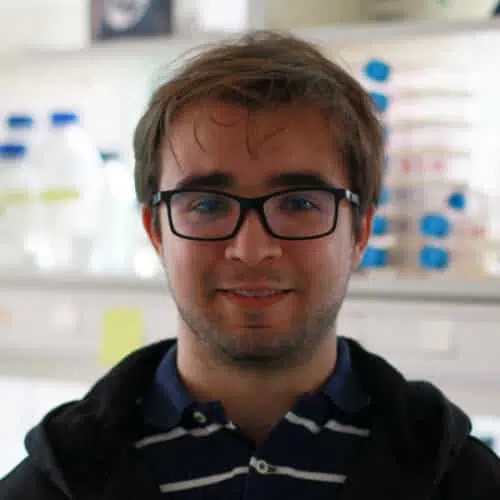Institut de Biologie Moléculaire et Cellulaire - UPR-9002 (CNRS)
"The viral protein NSP1 acts as a ribosome gatekeeper for shutting down host translation and fostering SARS-CoV-2 translation." RNA 27, 253–264 (2021) PMID: 33268501 PMCID: PMC7901841 DOI: 10.1261/rna.078121.120
Antonin Tidu, Aurélie Janvier, Laure Schaeffer, Piotr Sosnowski, Lauriane Kuhn, Philippe Hamman, Eric Westhof, Gilbert Eriani and Franck Martin.
Cv
Antonin Tidu, 25ans, ingénieur diplomé de l’Ecole Supérieure de Biotechnologies de Strasbourg en 2018, est actuellement doctorant dans l’équipe « Evolution des systèmes d’initiation de la traduction chez les Eucaryotes » au sein de l’UPR 9002 - ARN du CNRS, sous la direction de Franck Martin. Ses travaux sont focalisés sur l’étude des mécanismes moléculaires de régulation de l’initiation de la traduction chez les eucaryotes et la caractérisation d’IRES (Internal Ribosome Entry Site) dans des génomes viraux. Dans l’article primé, Antonin Tidu et ses collaborateurs décrivent comment la protéine virale NS1 du SARS-CoV-2 détourne la machinerie de traduction de la cellule infectée vers la traduction des ARNs viraux. La protéine NS1 en se fixant sur les ribosomes empêche la formation des complexes d’initiation. La présence d’une structure tige-boucle SL1 dans les partie 5’UTR des ARN viraux permet de neutraliser la fonction inhibitrice de NS1 ce qui permet la synthèse des protéines virales. L’importance fonctionnelle de cette structure SL1 dans le cycle de SARS-CoV-2 offre de nouvelles perspectives dans la recherche de drogues permettant de lutter contre la propagation de ce virus.
Contact
Institut de Biologie Moléculaire et Cellulaire - UPR-9002 (CNRS)
2 allée Konrad Roentgen
67084 Strasbourg, France
Cette adresse e-mail est protégée contre les robots spammeurs. Vous devez activer le JavaScript pour la visualiser.
Résumé de l'article
During the early stages of infection, the NSP1 protein is one of the first viral proteins produced. This NSP1 protein will immediately bind to the ribosome of the host cell and block the entry site to prevent access of the cell's messenger RNAs, which will then no longer be translated. In this way, the virus takes control of the cell's translational machinery and literally turns off cellular translation. However, the virus genome continues to be translated despite the presence of NSP1 on the ribosome. The experiments carried out made it possible to understand how the virus can bypass this blockage by the NSP1 protein. The virus has a small hairpin structure called SL1 in its messenger RNAs that allows it to open up access to the ribosome by acting on NSP1. The virus has a sort of key that allows it to continue translating by unlocking the ribosome blocked by the viral protein NSP1 during infection. This discovery is extremely important as it opens the way to new antiviral therapeutic approaches aimed at blocking the virus' cell cycle. Indeed, the primordial role of SL1 in the infection process makes this element of the virus a prime target for the development of new inhibiting molecules. Such molecules would be capable of specifically blocking the action of SL1, thus enabling the virus to be turned off. In short, the fact that SL1 is essential for viral translation suggests that this structure is a real 'Achilles heel' of the virus.




